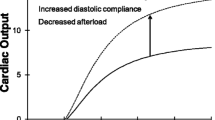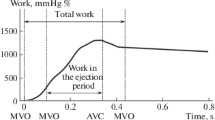Summary
We have recently shown that the mechanical efficiency of the contractile machinery of the canine left ventricle is constant at 30%–50%, independent of its loading, heart rate, and inotropic conditions. In contrast, the conventional mechanical efficiency of the ventricle is known to vary between 0 and 30%, depending on these conditions. In this study, we derived an equation for the conventional mechanical efficiency as a function of ventricular preload, afterload, and contractility, based on the constant mechanical efficiency of the contractile machinery. In deriving this equation, we fully utilized our new concept of the total mechanical energy of the left ventricle, i.e., systolic pressure-volume area, and our recent findings of the linear relationship between left ventricular oxygen consumption and the systolic pressure-volume area as well as the dependence of this relation on the ventricular inotropic state. As a result, the conventional mechanical efficiency of the left ventricle was found to change between 0 and 25% as an explicit function of these cardiodynamic and inotropic conditions. Using this function, we obtained combinations of loading and inotropic conditions to maximize the conventional mechanical efficiency of the left ventricle.
Similar content being viewed by others
References
Gibbs CL (1978) Cardiac energetics. Physiol Rev 58: 174–254
Suga H, Hayashi T, Shirahata M (1981) Ventricular systolic pressure-volume area as predictors of cardiac oxygen consumption. Am J Physiol 240: H39-H44
Suga H, Hisano R, Hirata S, Hayashi T, Yamada O, Ninomiya I (1983) Heart rate-independent energetics and systolic pressure-volume area in dog heart. Am J Physiol 244: H206-H214
Suga H, Hisano R, Goto Y, Yamada O, Igarashi Y (1983) Effect of positive inotropic agents on the relation between oxygen consumption and systolic pressure volume area in canine left ventricle. Circ Res 53: 306–318
Suga H, Yamada O, Goto Y, Igarashi Y, Ishiguri H (1984) Constant mechanical efficiency of contractile machinery of canine left ventricle under different loading and inotropic conditions. Jpn J Physiol 34: 679–698
Suga H, Sagawa K (1977) End-diastolic and end-systolic ventricular volume clamper for isolated canine heart. Am J Physiol 233: H718-H722
Suga H (1979) Total mechanical energy of a ventricle model and cardiac oxygen consumption. Am J Physiol 236: H498-H505
Suga H, Sagawa K, Shoukas AA (1973) Load independence of the instantaneous pressure-volume ratio of the canine left ventricle and effects of epinephrine and heart rate on the ratio. Circ Res 32: 256–263
Snedecor GW, Cochran WG (1971) Statistical methods. Iowa State Univ Press, Iowa, pp 419–446
Gibbs CL, Papadoyannis DE, Drake AJ, Noble MIM (1980) Oxygen consumption of the nonworking and potassium chloride-arrested dog heart. Circ Res 47: 408–417
Suga H (1979) External mechanical work from relaxing ventricle. Am J Physiol 236: H494-H497
Suga H, Hisano R, Ninomiya I (1982) Digital on-line computation of a predictor of cardiac oxygen consumption. Left ventricular systolic pressure volume area. Jpn Heart J 23: 749–758
Suga H, Sagawa K, Kostiuk DP (1976) Controls of ventricular contractility assessed by pressure-volume ratio,E max. Cardiovasc Res 10: 582–592
Evans CL, Matsuoka Y (1915) The effect of various mechanical conditions on the gaseous metabolism and efficiency of the mammalian heart. J Physiol (London) 49: 378–405
Sarnoff SJ, Braunwald E, Welch GH, Case RB, Stainsby WN, Marcruz R (1958) Hemodynamic determinants of oxygen consumption of the heart with special reference to the tension time index. Am J Physiol 192: 148–156
Bing RJ, Michal G (1959) Myocardial efficiency. Ann NY Acad Sci 72: 555–558
Author information
Authors and Affiliations
Rights and permissions
About this article
Cite this article
Suga, H., Igarashi, Y., Yamada, O. et al. Mechanical efficiency of the left ventricle as a function of preload, afterload, and contractility. Heart Vessels 1, 3–8 (1985). https://doi.org/10.1007/BF02066480
Issue Date:
DOI: https://doi.org/10.1007/BF02066480




